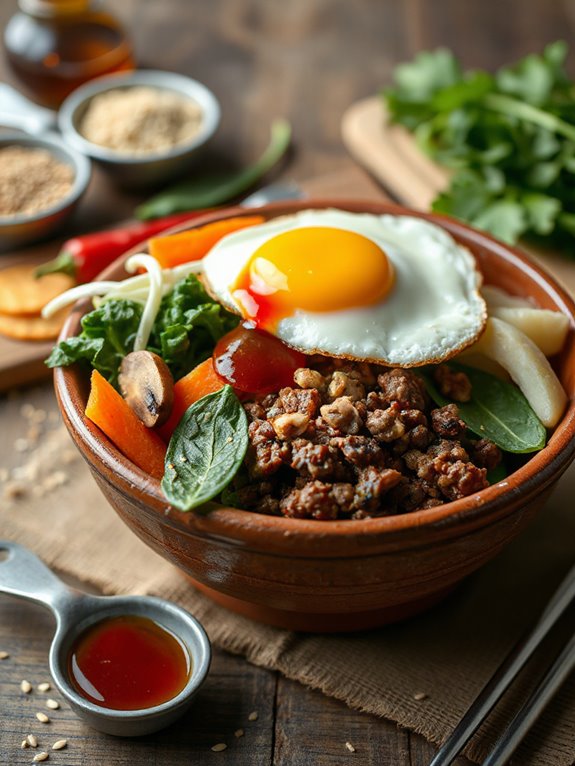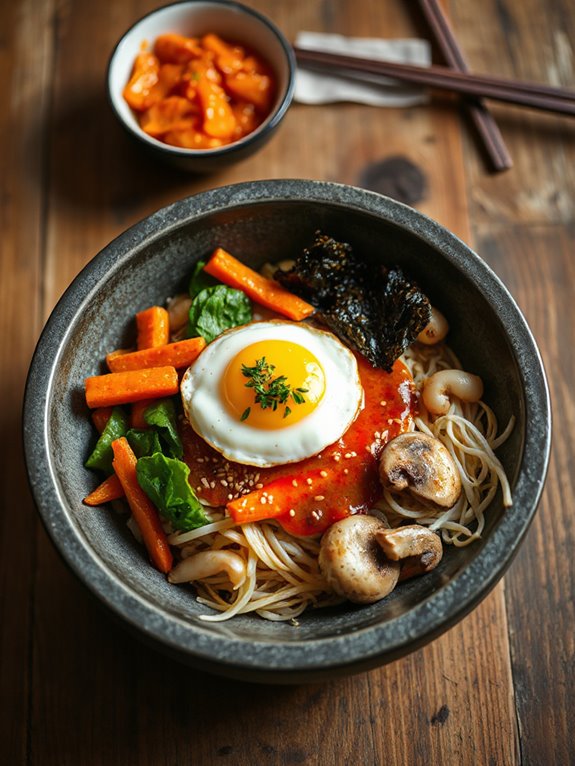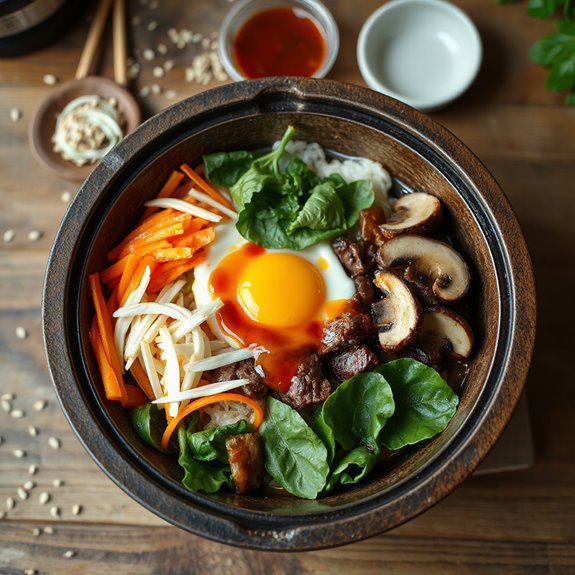Craving a vibrant explosion of flavor in a single bowl? Dive into the world of Bibimbap, Korea's iconic rice dish, and unlock the secrets to creating your own masterpiece.
Get ready to embark on a culinary adventure where colorful vegetables, savory beef, and a signature sauce unite in perfect harmony!
Mastering the Bibimbap Sauce

I'm telling you, the Bibimbap Sauce is where the magic happens! You can think of the other parts like the backup dancers, and the sauce is the star!
So, how do we nail this sauce? Easy peasy. Grab a bowl, and let's start building flavor. You'll need 4 tablespoons of gochujang – that's the spicy Korean miso paste; it's got a real kick!
Next, toss in 2 tablespoons each of mirin – that sweet Japanese cooking wine – and rice vinegar. Don't worry, it's not alcoholic! Then, stir in 1 1/2 teaspoons of soy sauce, 3 teaspoons of white sugar, and don't forget a finely grated clove of garlic. It brings a zing!
Finally, drizzle in 2 1/2 teaspoons of toasted sesame oil. The oil gives it that awesome, nutty essence. This sauce features a handful of essential seasonings common in Asian cuisine. Mix it up until the sugar vanishes, and boom – you've got the sauce that'll make your Bibimbap sing.
Preparing the Components

Now, let's get to the heart of things with preparing the components – it's like setting up your art supplies before painting a masterpiece! I'll walk you through each ingredient.
First, I'm marinating the beef. Grate a 1/4 of a green apple, then I'll mix it with minced garlic, soy sauce, honey, and sesame oil! Let it sit for at least 30 minutes. To change up the flavor profile, different marinades like that which is used for satay can be experimented with in this step.
Next, I'm tackling the veggies. I'm cutting the carrots and zucchini into batons, and soaking the shiitake mushrooms. Remember to squeeze out the excess water later! Also, I'll get the bean sprouts ready for a quick steam or simmer! They deserve a cold water bath!
Now, I'm cooking! I'm sautéing each vegetable separately – shiitake, carrot, zucchini, spinach and bean sprouts. Don't overcrowd the pan. Each veggie gets its own moment to shine. I'll use oil, garlic, soy sauce, salt, sugar, and fish sauce for seasoning. It's like conducting a delicious symphony each time!
Assembling Your Bibimbap

With all our components prepped and ready to go, we can move onto the exciting part—assembling your bibimbap! First, place warm rice—about 4 cups—in your bowl.
Now for the fun! Arrange those colorful veggies and beef on top. Think of it like making edible art. Don't be shy; pile it on!
Next, gently place a fried egg—sunny-side up, if you're feeling fancy—right on top! Drizzle generously with sesame oil and sprinkle with sesame seeds. Yum!
Finally, grab your Bibimbap Sauce—remember that amazing mixture we made? Add as much as you like! I usually go for about 4 tablespoons, but hey, you do you!
Now, for the best part – mix it all up! Don't be afraid to get in there! Then, dig in and enjoy your delicious, homemade Bibimbap!
Short Recipe Version
Bibimbap Recipe
Prep Time: 20 minutes
Cook Time: 25 minutes
Servings: 2
Ingredients:
- 1 cup cooked rice
- 8 oz beef sirloin, thinly sliced
- 1 tbsp soy sauce
- 1 tsp sesame oil
- 1/2 tsp garlic, minced
- 1 carrot, julienned
- 1 cucumber, julienned
- 4 oz spinach, blanched
- 2 eggs
- 2 tbsp gochujang (Korean chili paste)
- 1 tbsp sesame seeds
Instructions:
- Marinate beef with soy sauce, sesame oil, and garlic.
- Stir-fry beef until cooked.
- Sauté carrot and cucumber separately until tender.
- Fry eggs to your liking (sunny-side up recommended).
- In a bowl, arrange rice, beef, vegetables, and egg.
- Drizzle with gochujang and sprinkle with sesame seeds.
- Mix well before eating.
Nutrition Information (per serving, estimated):
- Calories: 600
- Protein: 35g
- Fat: 25g
- Carbohydrates: 60g
